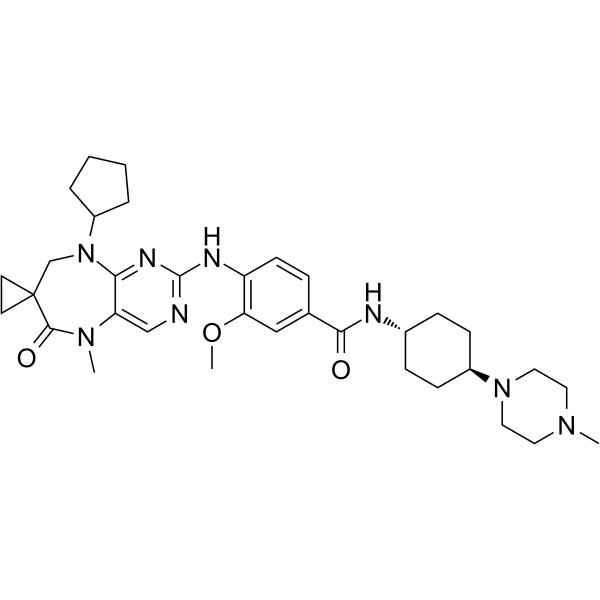Plogosertib
Modify Date: 2024-01-04 16:23:43

Plogosertib structure
|
Common Name | Plogosertib | ||
|---|---|---|---|---|
| CAS Number | 1137212-79-3 | Molecular Weight | 616.80 | |
| Density | N/A | Boiling Point | N/A | |
| Molecular Formula | C34H48N8O3 | Melting Point | N/A | |
| MSDS | N/A | Flash Point | N/A | |
Use of PlogosertibPlogosertib (CYC140) is a selective, potent, and orally active ATP-competitive PLK1 inhibitor (IC50: 3 nM). Plogosertib is an anti-cancer agent with anti-proliferative activity. Plogosertib can be used in the research of several tumors, including esophageal, gastric, leukemia, non–small cell lung cancer, ovarian, and squamous cell cancers[1][2]. |
| Name | Plogosertib |
|---|
| Description | Plogosertib (CYC140) is a selective, potent, and orally active ATP-competitive PLK1 inhibitor (IC50: 3 nM). Plogosertib is an anti-cancer agent with anti-proliferative activity. Plogosertib can be used in the research of several tumors, including esophageal, gastric, leukemia, non–small cell lung cancer, ovarian, and squamous cell cancers[1][2]. |
|---|---|
| Related Catalog | |
| Target |
PLK1:3 nM (IC50) PLK2:149 nM (IC50) PLK3:393 nM (IC50) |
| In Vitro | Plogosertib (CYC140) selectively inhibits PLK1 (IC50: 3 nM), and is >50 fold more potent against PLK2 and PLK3 (IC50s: 149 nM and 393 nM, respectively)[2]. Plogosertib (0-4 μΜ, 2 h) reduces phosphorylation of the PLK1 substrate, pSer4-nucleophosmin (p-NPM) in KYSE-410 cells[2]. Plogosertib (100 nM, 24 h) increases in the proportion of mitotic cells, with increased monopolar spindles in HeLa cells[2]. Plogosertib (72 h) preferentially inhibits cell proliferation in malignant cell lines (IC50s: 14-21 nM), and is less toxic against none-malignant cell lines (IC50: 82 nM)[2]. Cell Proliferation Assay[2] Cell Line: KYSE-410 cells Concentration: 0, 0.07, 0.15, 0.3, 0.6, 1.25 μΜ Incubation Time: 72 h Result: Inhibited cell proliferation in a concentration-dependent manner. Western Blot Analysis[2] Cell Line: KYSE-410 cells Concentration: 0, 0.01, 0.025, 0.05, 0.1, 0.25, 0.5, 1, 2, 4 μΜ Incubation Time: 2 h (p-NPM), 24 h (p-HH3), 72 h (cPARP) Result: Reduced phosphorylation of the PLK1 substrate (p-NPM). Increased in the mitotic marker pSer10 histone H3 (p-HH3), and the cleavage of PARP (cPARP, an indicator of cell death). |
| In Vivo | Plogosertib (CYC140, oral administration, 40 mg/kg, qd 5/2/5) inhibits tumor growth in preclinical xenograft models of acute leukemia and solid tumors[2].Plogosertib (Coumpond A7, 1 mg/kg, mouse) shows pharmacokinetic parameters: Cmax (453 ng/mL), AUC (377 hr•ng/mL), Cl (2445 mL/h/kg)[3]. Animal Model: HL60 promyelocytic leukemia xenograft[2] Dosage: 40, 54, 67 mg/kg, qd 5/2/5 Administration: Oral administration Result: Inhibited tumor growth (>87%) without significant loss in body weight. Animal Model: OE19 esophageal xenograft[2] Dosage: 40 mg/kg, qd 5/2 Administration: Oral administration Result: Inhibited tumor growth (61 % inhibition). |
| References |
| Molecular Formula | C34H48N8O3 |
|---|---|
| Molecular Weight | 616.80 |